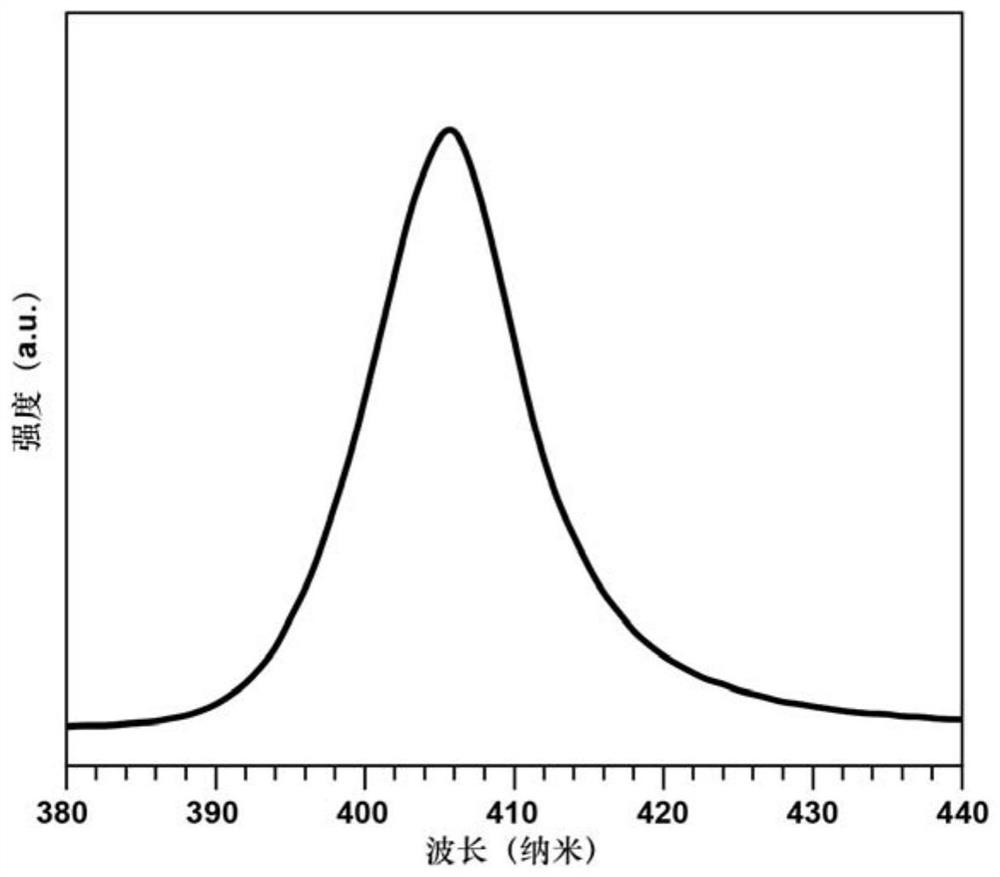Preparation method and application of composite material
A composite material and packaging method technology, which is applied in the fields of luminescent materials, chemical instruments and methods, semiconductor/solid-state device manufacturing, etc. question
- Summary
- Abstract
- Description
- Claims
- Application Information
AI Technical Summary
Problems solved by technology
Method used
Image
Examples
Embodiment 1
[0159] The polymer polystyrene (PS) and PbBr 2 Powder and MABr (MA refers to methylamine) powder are mixed, and the control mass ratio is: Polymer: (PbBr 2 +MABr)=100:5, control drug MABr:PbBr 2 The molar ratio is: 1:1. Mix the powder evenly with mechanical agitation. Then extrude at a temperature of 190°C at the feed inlet section, at a temperature of 210°C at the melting section, for 6 minutes, at a temperature of 220°C at the mixing section, for 30 minutes, at a temperature of 190°C at the mold forming section, and at a speed of 1000 rpm. Get MAPbBr 3Quantum dot / PS composite diffusion plate. The sample has a thickness of 1.5 mm. The fluorescence emission spectrum of the sample is as figure 1 shown, from figure 1 It can be seen that the emission wavelength is located at 516nm, and the half-maximum width is 22nm.
Embodiment 2
[0161] The polymer polystyrene (PS) and the experimental drug PbCl 2 Powder and CsCl powder are mixed, and the control mass ratio is: Polymer: (PbCl 2 +CsCl)=100:1, control drug CsCl:PbCl 2 The molar ratio is: 1:1.1. Mix the powder evenly with mechanical agitation. Then extrude at a temperature of 190°C at the feed inlet section, at a temperature of 210°C at the melting section, for 8 minutes, at a temperature of 220°C at the mixing section, for 40 minutes, at a temperature of 190°C at the mold forming section, and at a speed of 1000 rpm. Get CsPbCl 3 Quantum dot / PS composite diffusion plate. The sample had a thickness of 1.25 mm. The fluorescence emission spectrum of the sample is as figure 2 shown, from figure 2 It can be seen that the emission wavelength is at 405nm, and the half-maximum width is 19nm.
Embodiment 3
[0163] The polymer polystyrene (PS) and the experimental drug PbI 2 Powder and MAI powder are mixed, and the control mass ratio is: Polymer: (PbI 2 +MAI)=100:0.1, control drug MAI:PbI 2 The molar ratio is: 1:1.2. Mix the powder evenly with mechanical agitation. Then extrude at a temperature of 195°C at the feed inlet section, at a temperature of 210°C at the melting section, for 10 minutes, at a temperature of 220°C at the mixing section, for 20 minutes, at a temperature of 190°C at the mold forming section, and at a speed of 1000 rpm. Get-CsPbI 3 Quantum dot / PS composite diffusion plate. The thickness of this sample is 0.5 mm. The fluorescence emission spectrum of the sample is as image 3 shown, from image 3 It can be seen that the emission wavelength is at 675nm, and the half-maximum width is 32nm.
PUM
| Property | Measurement | Unit |
|---|---|---|
| size | aaaaa | aaaaa |
| thickness | aaaaa | aaaaa |
| thickness | aaaaa | aaaaa |
Abstract
Description
Claims
Application Information
 Login to View More
Login to View More - R&D Engineer
- R&D Manager
- IP Professional
- Industry Leading Data Capabilities
- Powerful AI technology
- Patent DNA Extraction
Browse by: Latest US Patents, China's latest patents, Technical Efficacy Thesaurus, Application Domain, Technology Topic, Popular Technical Reports.
© 2024 PatSnap. All rights reserved.Legal|Privacy policy|Modern Slavery Act Transparency Statement|Sitemap|About US| Contact US: help@patsnap.com










